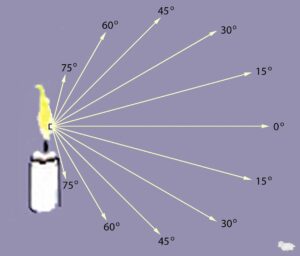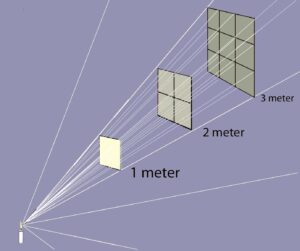Main Body
5 PHOTONS RADIATE

This is true for any point in a candle flame, on a glowing wire in a light bulb, and in a light emitting diode.
The number of photons emitted in various directions from any point on an ideal source looks like this:
The line lengths are proportional to the number of photons in the ray (its intensity) in that direction.
e.g. The 60 degree ray has half the intensity of the direct ray.
In 1760 Lambert found the decrease in photons at any angle could be estimated by multiplying the intensity of the direct ray by the angle’s cosine.
Surfaces the emit light in this manner are therefore called “Lambertian”.
p. 14
This radiation of photons from a source has serious consequences for lighting: The further the source, the weaker the radiation’s strength per unit area (or illuminance, but that comes later, page 80): 
The same number of photons reaching a square at 1 meter, spreads out over 4 squares
at 2 meters, spreads over 9 squares at 3 meters, and so forth.
By simple geometry the number of photons per unit area decreases with distance squared.
At 3 times the distance, a light meter finds the illumination to be 1/9 th of what it measured at 1 meter from a source.
Thus we have the Inverse Square Law describing the effectiveness of radiation at a distance.
p. 15
Then why doesn’t a candle look dimmer as you walk away?
This question actually applies not only to candles or light bulbs, but also to everything we see.
The explanation (page 36) comes from physics not perception.
However, that requires understanding some optics.
First, let’s consider why it applies to (almost) everything we see:
